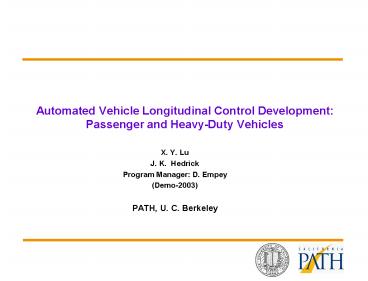Automated Vehicle Longitudinal Control Development: Passenger and Heavy-Duty Vehicles - PowerPoint PPT Presentation
1 / 40
Title:
Automated Vehicle Longitudinal Control Development: Passenger and Heavy-Duty Vehicles
Description:
Merging Simulation for High Speed Implementation. Transition Control - From ... Prominent disturbance during gear shifting. Modeling. Engine. Other ... gear ... – PowerPoint PPT presentation
Number of Views:213
Avg rating:3.0/5.0
Title: Automated Vehicle Longitudinal Control Development: Passenger and Heavy-Duty Vehicles
1
Automated Vehicle Longitudinal Control
Development Passenger and Heavy-Duty Vehicles
- X. Y. Lu
- J. K. Hedrick
- Program Manager D. Empey
- (Demo-2003)
- PATH, U. C. Berkeley
2
Part 1. Passenger Cars
- Merging Simulation for High Speed Implementation
- Transition Control - From Manual to Automatic
- Real-time Tire Slip Ratio Estimation
3
Merging Simulation for High Speed Implementation
- General merging maneuver
- Minimizing acceleration demanding of merging
vehicle - Dynamic real-time simulation PATH home page
- http//www.path.berkeley.edu/PA
TH/General/WhatsNew/
4
Transition control - From Manual to Automatic
- Longitudinal Transition Control
- For operation of single vehicle
- Multiple transitions between manual and automatic
- To be able to automatically stop in the end of
test track - Control problem Dynamic trajectory planning
5
Transition when v lt max_spd
6
Transition when v gt max_spd
7
Real-time Tire Slip Ratio Estimation
- Friction Models (static or dynamic) are Tire Slip
Dependent - Tire Slip Definition Based on Short Distance
- Easy to implement
- Can be used for static and dynamic friction
models - Application to Vehicle Longitudinal moving
Distance Measurements - Vehicle in AHS installed with magnets
- Vehicles with GPS in normal highway systems
(similar and omitted)
8
Tire Slip Definition Based on Vehicle Speed
9
Tire Slip Definition Based on Short Distance
10
Distance Measurement Vehicle in AHS installed
with magnets
- Tire slip in moving distance measurement based on
magnets
11
Distance Measurement Vehicle in AHS installed
with magnets
12
Part 2. Heavy Duty Trucks
- Modeling and Control System Structure
- Main Characteristics From Control Point of View
- Modeling
- Upper Level Control
- Lower Level Control
- Communication Systems
- Most Difficult Problems in Control
13
Modeling Control System Structure
Air
Turbocharger
Lockup
Transmission Retarder
Torque Converter
Engine
Automatic Transmission
EGR
Engine Brake
Propeller shaft
Exhaust
Tire
Pneumatic Brake
Final Driving Gear
Drive shaft
Wheel speed
Tire slip effect
Control
Sensors Comm. Syst.
Vehicle speed
14
Main Characteristics From Control Point of View
- Mass dominant road inclination
plays a major roll - Low (power / inertia) ratio
Throttle saturation - Large time delay in actuators, mainly air brake
- Large load variation
- Prominent disturbance during gear shifting
15
Modeling
- Engine
- Other Power Consumption
- Drive-line
- Engine Braking Effect
- Rolling Resistance
16
Engine
17
Engine (Eng_brk 0)
Air
Turbocharger
Pm
Engine_fric torque
-
Engine
Net Output Torque
EGR
Engine_ind torque
Exhaust
18
Engine (Eng_brk 2,4)
Engine_ind_torque gt Engine_fric torque
engine_comp torque
Air
Turbocharger
Pm
Engine_fric torque
-
Engine
Net Output Torque
Engine_ind torque
EGR
Engine_comp torque
-
Exhaust
19
Engine (Eng_brk 2,4)
Engine_ind_torque lt Engine_fric torque
engine_comp torque
Air
Turbocharger
Pm
Engine_fric torque
-
Engine
Total Eng_brk Torque
Engine_ind torque
EGR
Engine_comp torque
-
Exhaust
20
Engine (Eng_brk 6)
Air
Turbocharger
Pm
-
Engine
Engine_fric torque
Total Eng-brk Torque
EGR
Engine_comp torque
-
Exhaust
21
Other Power Consumption
- New Freightliner Total power 435hp
- Fan (clutch engaged)
- Air compressor
- Alternator
- Air conditioner Compressor
22
Drive-line
- Torque Converter
- Drive line Torsional Effect and Its Compensation
in Platoon Control Design - At low speed
- During gear shifting
- Maneuver with large torque demanding (large
acceleration, deceleration grading)
23
Engine Braking Effect
- Total resistance in longitudinal direction can be
divided into two parts
24
Rolling Resistance
- Rolling Resistance - function of vehicle speed
and mass
25
(No Transcript)
26
(No Transcript)
27
Upper Level Control
- General Strategy
- Sensors and Actuators (Do as it is)
- Close-loop Open-loop vehicle mass estimation
- Following Strategy, Data Fusion and String
Stability
28
General Strategy Model based
- System Uncertainties
- Model mismatch
- External disturbances
- Sensor noises
- To reduce model mismatch as much as possible
- To choose proper filters
- To design controller with less overshoot (to deal
with saturation) - Developing prediction technique (to deal with
time delay)
29
Sensors and Actuators (Do as it is)
- Two Radar Systems Eaton Vorad Lidar
- Magnetometer
- Inclinometer
- Built-in sensors
- Speedometer
- Accelerometer
- brake pressure
- Other J-BUS readings
- No extra actuator to be added
30
Close-loop open-loop vehicle mass estimation
- For string stability
- To be established during a short time after
vehicle start moving
31
Following Strategy, Data Fusion and String
Stability
- Two-way (multi-way) following
- Corporative Platooning
- Optimal dynamic trajectory planning for leader
vehicle - Following and data fusion strategy in normal
mode and sensor fault mode
32
Following Strategy, radar and/or magnetometer
is normal
33
Following Strategy, radar and/or magnetometer
is normal
34
Following Strategy, radar and magnetometer fault
35
Following Strategy, communication fault ?
36
Control Design Methods
- Multiple surface sliding mode Nonlinear
H-infinity - Newly developed continuous finite time sliding
mode - New filtering and observer techniques
- Other nonlinear control techniques
37
Lower Level Control
- Internal (built-in) Throttle Control System
- Torque control command
- Speed control command
- Fuel rate limit to guarantee optimal performance
Turbocharger
Air
Pm
Eng-speed
Engine
Throttle Dynamics
Fuel Rate
Des-Eng-speed
PI Controller
Des-Output Tq
Eng-Net-Torque
Exhaust
38
Lower Level Control (cont.)
- Brake Control System
- Combination of
- Engine brake
- Air brake
- Transmission retarder
- Taking into consideration of Engine Braking
Effect - Proper coordination
39
Communication System
- 2-way communication 2.4 GHz WaveLAN Radio
- Range 300500m
40
Most Difficult Problems
- Proper data fusion and optimal trajectory
planning for string stability - To deal with road inclination (grade) with
reasonably good performance - To overcome time delay in actuators































